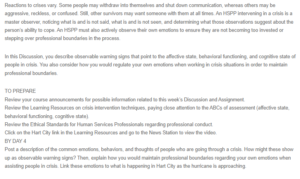Crisis Behaviors and Emotions
People going through a crisis may experience a wide range of emotions, behaviors, and thoughts. Emotionally, they might feel overwhelmed, anxious, fearful, angry, or even numb. These emotions can manifest as observable warning signs, such as tearfulness, agitation, restlessness, irritability, or emotional detachment. Individuals in crisis may have difficulty sleeping, eating, or concentrating (humade & Shnishil, 2023). They might also engage in impulsive or risky behaviors as a way to cope with their distress. Some individuals may withdraw from others, avoiding communication and social interactions, while others might seek constant company for comfort. Cognitively, people in crisis may have racing thoughts, confusion, or a sense of helplessness. They may struggle to make decisions and might exhibit poor judgment.
To maintain professional boundaries when assisting people in crisis, it is crucial for an HSPP (Human Services Professional Practitioner) to actively observe and regulate their own emotions. Empathy and compassion are essential in providing support, but becoming overly emotionally invested can hinder the practitioner’s ability to remain objective and make sound judgments (Beaumont et al., 2021). One strategy is to practice self-awareness and recognize any signs of becoming too emotionally involved. Engaging in regular self-reflection and seeking supervision or support from colleagues can help process these emotions in a healthy way.
In the case of Hart City, as the hurricane approaches and its aftermath unfolds, emotions might run high for both the affected individuals and the HSPPs providing assistance. There could be a mix of fear, anxiety, frustration, and sadness among the residents, making it challenging to maintain a sense of emotional distance. As an HSPP, it is important to acknowledge these emotions without suppressing them but also avoid letting them cloud judgment or influence decision-making. Engaging in debriefing sessions with colleagues and supervisors can help process the emotions experienced during crisis interventions (Wasilowsky & Valeriano, 2012). Additionally, staying up-to-date with ethical standards for professional conduct is essential in ensuring that the well-being and privacy of the affected individuals are prioritized throughout the intervention process.
References
Beaumont, E., Bell, T., McAndrew, S., & Fairhurst, H. (2021). The impact of compassionate mind training on qualified health professionals undertaking a compassion‐focused therapy module. Counseling and Psychotherapy Research. https://doi.org/10.1002/capr.12396
humade, S. H., & Shnishil, A. T. (2023). Sleep disturbance among persons over 40 years old. https://doi.org/10.1063/5.0135989
Wasilowsky, M., & Valeriano, B. (2012). A Proactive Approach to Stress Management in a Neuroscience Intensive Care Unit. Pennsylvania Nurse, 67(2), 12–18. https://scholarlyworks.lvhn.org/cgi/viewcontent.cgi?article=1148&context=patient-care-services-nursing
ORDER A PLAGIARISM-FREE PAPER HERE
We’ll write everything from scratch
Question 
Reactions to crises vary. Some people may withdraw into themselves and shut down communication, whereas others may be aggressive, reckless, or confused. Still, other survivors may want someone with them at all times. An HSPP intervening in a crisis is a master observer, noticing what is and is not said, what is and is not seen, and determining what those observations suggest about the person’s ability to cope. An HSPP must also actively observe their own emotions to ensure they are not becoming too invested or stepping over professional boundaries in the process.

Crisis Behaviors and Emotions
In this Discussion, you describe observable warning signs that point to the affective state, behavioral functioning, and cognitive state of people in crisis. You also consider how you would regulate your own emotions when working in crisis situations in order to maintain professional boundaries.
TO PREPARE
Review your course announcements for possible information related to this week’s Discussion and Assignment.
Review the Learning Resources on crisis intervention techniques, paying close attention to the ABCs of assessment (affective state, behavioral functioning, cognitive state).
Review the Ethical Standards for Human Services Professionals regarding professional conduct.
Click on the Hart City link in the Learning Resources and go to the News Station to view the video.
BY DAY 4
Post a description of the common emotions, behaviors, and thoughts of people who are going through a crisis. How might these show up as observable warning signs? Then, explain how you would maintain professional boundaries regarding your own emotions when assisting people in crisis. Link these emotions to what is happening in Hart City as the hurricane is approaching.

